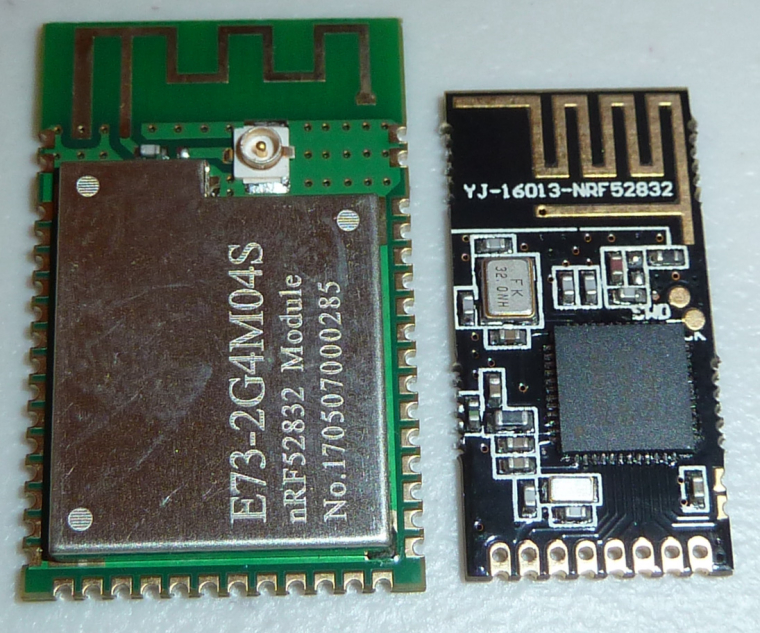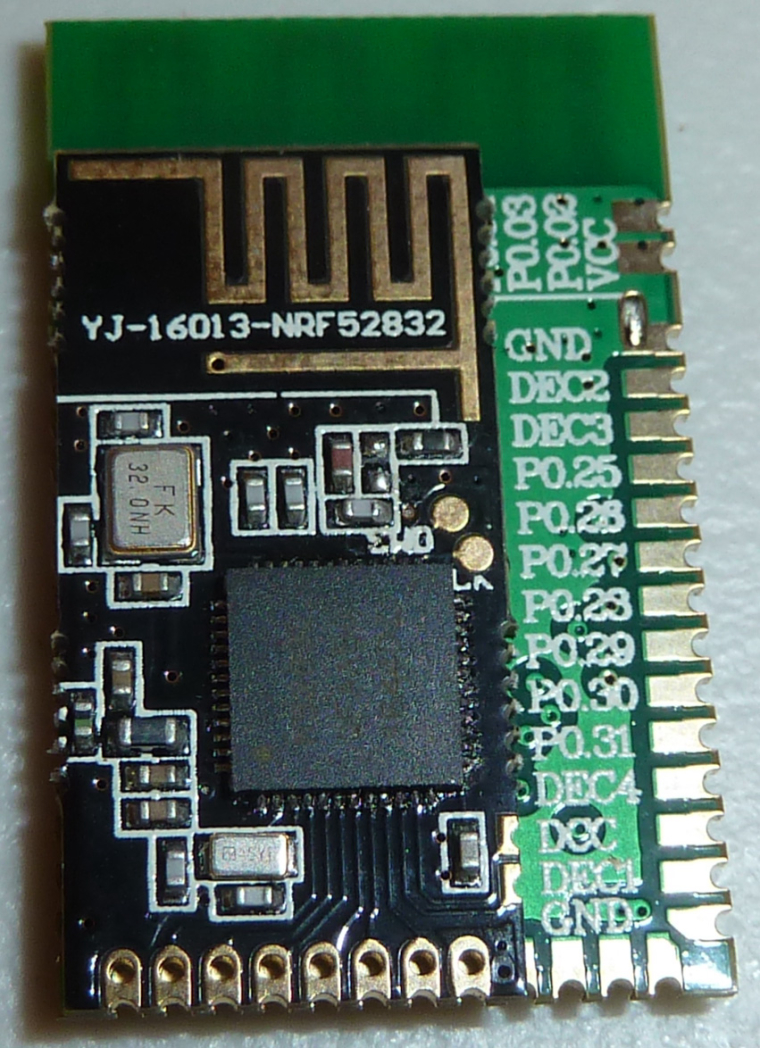nRF5 action!
-
Unfortunately, after I add:
#include <mySensors.h>the locus of control goes somewhere else (I guess the gateway or something?). Anyhow, it makes this very hard to debug.
For instance, the pin of interest is PIN_AIN0. I can't find where it's defined, and I can't print out its value either, because of this locus of control issue.
Anyhow, I think I may wait for others to get up and running with their modules, and start facing the same issues. Maybe then we can help each other figure this stuff out.
-
@NeverDie I don't know why the println() doesn't work. There is an "DEBUG_OUTPUT(x, ##VA_ARGS)" macro, you can use when debug is enabled.
NRF_ADC is the nRF51 ADC and NRF_SAADC is the ADC of the nRF52. They are defined when "nrf.h" is included.
What board type have use used for your tests?
-
@NeverDie I don't know why the println() doesn't work. There is an "DEBUG_OUTPUT(x, ##VA_ARGS)" macro, you can use when debug is enabled.
NRF_ADC is the nRF51 ADC and NRF_SAADC is the ADC of the nRF52. They are defined when "nrf.h" is included.
What board type have use used for your tests?
@d00616 said in nRF5 Bluetooth action!:
What board type have use used for your tests?
The nRF52832 Ebyte Module.
-
@d00616 said in nRF5 Bluetooth action!:
hwCPUVoltage()
I'm finally installing Visual Micro, because I hope it will help me quickly find where all these functions are defined. With all these new layers, the Arduino IDE is just no longer cutting it.
-
@NeverDie I don't know why the println() doesn't work. There is an "DEBUG_OUTPUT(x, ##VA_ARGS)" macro, you can use when debug is enabled.
NRF_ADC is the nRF51 ADC and NRF_SAADC is the ADC of the nRF52. They are defined when "nrf.h" is included.
What board type have use used for your tests?
@d00616 said in nRF5 Bluetooth action!:
What board type have use used for your tests?
I just re-read your question and realized you were asking something else than the question that I answered above.
Answer: nRF52 DK is the board type, because I wired directly to P0.06 as its Tx pin on the Ebyte nRF52832 Module.
-
@Terrence said in nRF5 Bluetooth action!:
VS Code with the Arduino Extension is your friend.
I'll try that. Maybe it will be a little less of a learning curve than Visual Micro yet still do what I need.
-
I just now did a brute force hack of the MySensors BatteryPoweredSensor sketch, where I copied and renamed the hwCPUVoltage function from the library and then called it from within a tight loop so that I never lose the locus of control. It worked!
/** * The MySensors Arduino library handles the wireless radio link and protocol * between your home built sensors/actuators and HA controller of choice. * The sensors forms a self healing radio network with optional repeaters. Each * repeater and gateway builds a routing tables in EEPROM which keeps track of the * network topology allowing messages to be routed to nodes. * * Created by Henrik Ekblad <henrik.ekblad@mysensors.org> * Copyright (C) 2013-2015 Sensnology AB * Full contributor list: https://github.com/mysensors/Arduino/graphs/contributors * * Documentation: http://www.mysensors.org * Support Forum: http://forum.mysensors.org * * This program is free software; you can redistribute it and/or * modify it under the terms of the GNU General Public License * version 2 as published by the Free Software Foundation. * ******************************* * * DESCRIPTION * * This is an example that demonstrates how to report the battery level for a sensor * Instructions for measuring battery capacity on A0 are available here: * http://www.mysensors.org/build/battery * */ // Enable debug prints to serial monitor //#define MY_DEBUG // Enable and select radio type attached //#define MY_RADIO_NRF24 //#define MY_RADIO_RFM69 #define MY_RADIO_NRF5_ESB //#include <MySensors.h> int BATTERY_SENSE_PIN = A0; // select the input pin for the battery sense point //unsigned long SLEEP_TIME = 900000; // sleep time between reads (seconds * 1000 milliseconds) unsigned long SLEEP_TIME = 1000; // sleep time between reads (seconds * 1000 milliseconds) int oldBatteryPcnt = 0; uint16_t counter=0; uint16_t volts=0; uint16_t theHwCPUVoltage() { // VDD is prescaled 1/3 and compared with the internal 1.2V reference Serial.println("Inside hwCPUVoltage function."); #if defined(NRF_ADC) Serial.println("This is an NRF_ADC."); // NRF51: // Sampling is done with lowest resolution to minimize the time // 20uS@260uA // Concurrent ressource: disable uint32_t lpcomp_enabled = NRF_LPCOMP->ENABLE; NRF_LPCOMP->ENABLE = 0; // Enable and configure ADC NRF_ADC->ENABLE = 1; NRF_ADC->CONFIG = (ADC_CONFIG_EXTREFSEL_None << ADC_CONFIG_EXTREFSEL_Pos) | (ADC_CONFIG_PSEL_Disabled << ADC_CONFIG_PSEL_Pos) | (ADC_CONFIG_REFSEL_VBG << ADC_CONFIG_REFSEL_Pos) | (ADC_CONFIG_INPSEL_SupplyOneThirdPrescaling << ADC_CONFIG_INPSEL_Pos) | (ADC_CONFIG_RES_8bit << ADC_CONFIG_RES_Pos); NRF_ADC->EVENTS_END = 0; NRF_ADC->TASKS_START = 1; while(!NRF_ADC->EVENTS_END); NRF_ADC->EVENTS_END = 0; int32_t sample = (int32_t)NRF_ADC->RESULT; NRF_ADC->TASKS_STOP = 1; NRF_ADC->ENABLE = 0; // Restore LPCOMP state NRF_LPCOMP->ENABLE = lpcomp_enabled; return (sample*3600)/255; #elif defined(NRF_SAADC) // NRF52: // Sampling time 3uS@700uA Serial.println("This is an NRF_SAADC."); int32_t sample; NRF_SAADC->ENABLE = SAADC_ENABLE_ENABLE_Enabled << SAADC_ENABLE_ENABLE_Pos; NRF_SAADC->RESOLUTION = SAADC_RESOLUTION_VAL_8bit << SAADC_RESOLUTION_VAL_Pos; NRF_SAADC->CH[0].PSELP = SAADC_CH_PSELP_PSELP_VDD << SAADC_CH_PSELP_PSELP_Pos; NRF_SAADC->CH[0].CONFIG = (SAADC_CH_CONFIG_BURST_Disabled << SAADC_CH_CONFIG_BURST_Pos) | (SAADC_CH_CONFIG_MODE_SE << SAADC_CH_CONFIG_MODE_Pos) | (SAADC_CH_CONFIG_TACQ_3us << SAADC_CH_CONFIG_TACQ_Pos) | (SAADC_CH_CONFIG_REFSEL_Internal << SAADC_CH_CONFIG_REFSEL_Pos) | (SAADC_CH_CONFIG_GAIN_Gain1_6 << SAADC_CH_CONFIG_GAIN_Pos) | (SAADC_CH_CONFIG_RESN_Bypass << SAADC_CH_CONFIG_RESN_Pos) | (SAADC_CH_CONFIG_RESP_Bypass << SAADC_CH_CONFIG_RESP_Pos); NRF_SAADC->OVERSAMPLE = SAADC_OVERSAMPLE_OVERSAMPLE_Bypass << SAADC_OVERSAMPLE_OVERSAMPLE_Pos; NRF_SAADC->SAMPLERATE = SAADC_SAMPLERATE_MODE_Task << SAADC_SAMPLERATE_MODE_Pos; NRF_SAADC->RESULT.MAXCNT = 1; NRF_SAADC->RESULT.PTR = (uint32_t)&sample; NRF_SAADC->EVENTS_STARTED = 0; NRF_SAADC->TASKS_START = 1; while (!NRF_SAADC->EVENTS_STARTED); NRF_SAADC->EVENTS_STARTED = 0; NRF_SAADC->EVENTS_END = 0; NRF_SAADC->TASKS_SAMPLE = 1; while (!NRF_SAADC->EVENTS_END); NRF_SAADC->EVENTS_END = 0; NRF_SAADC->EVENTS_STOPPED = 0; NRF_SAADC->TASKS_STOP = 1; while (!NRF_SAADC->EVENTS_STOPPED); NRF_SAADC->EVENTS_STOPPED = 1; NRF_SAADC->ENABLE = (SAADC_ENABLE_ENABLE_Disabled << SAADC_ENABLE_ENABLE_Pos); return (sample*3600)/255; #else Serial.println("Unknown MCU!!"); // unknown MCU return 0; #endif } void setup() { Serial.begin(115200); Serial.println("Setup procedure beginning."); while (true) { volts=theHwCPUVoltage(); Serial.print("counter="); Serial.print(counter++); Serial.print(", hwCPUVoltage="); Serial.println(volts); } // use the 1.1 V internal reference //#if defined(__AVR_ATmega2560__) // analogReference(INTERNAL1V1); //#else // analogReference(INTERNAL); //#endif }Here is a sample of the output:
Inside hwCPUVoltage function. This is an NRF_SAADC. counter=5013, hwCPUVoltage=3303 Inside hwCPUVoltage function. This is an NRF_SAADC. counter=5014, hwCPUVoltage=3303 Inside hwCPUVoltage function. This is an NRF_SAADC. counter=5015, hwCPUVoltage=3303 Inside hwCPUVoltage function. This is an NRF_SAADC. counter=5016, hwCPUVoltage=3303 Inside hwCPUVoltage function. This is an NRF_SAADC. counter=5017, hwCPUVoltage=3303 Inside hwCPUVoltage function. This is an NRF_SAADC. counter=5018, hwCPUVoltage=3303 Inside hwCPUVoltage function. This is an NRF_SAADC. counter=5019, hwCPUVoltage=3303 Inside hwCPUVoltage function. This is an NRF_SAADC. counter=5020, hwCPUVoltage=3303 Inside hwCPUVoltage function. This is an NRF_SAADC. counter=5021, hwCPUVoltage=3303 Inside hwCPUVoltage function. This is an NRF_SAADC. counter=5022, hwCPUVoltage=3303 Inside hwCPUVoltage function. This is an NRF_SAADC. counter=5023, hwCPUVoltage=3303 Inside hwCPUVoltage function. This is an NRF_SAADC. counter=5024, hwCPUVoltage=3303 Inside hwCPUVoltage function. This is an NRF_SAADC. counter=5025, hwCPUVoltage=3303 Inside hwCPUVoltage function. This is an NRF_SAADC. counter=5026, hwCPUVoltage=3303 Inside hwCPUVoltage function. This is an NRF_SAADC. counter=5027, hwCPUVoltage=3303 Inside hwCPUVoltage function. This is an NRF_SAADC. counter=5028, hwCPUVoltage=3303 Inside hwCPUVoltage function. This is an NRF_SAADC. counter=5029, hwCPUVoltage=3303 Inside hwCPUVoltage function. This is an NRF_SAADC. counter=5030, hwCPUVoltage=3289 Inside hwCPUVoltage function. This is an NRF_SAADC. counter=5031, hwCPUVoltage=3303 Inside hwCPUVoltage function. This is an NRF_SAADC. counter=5032, hwCPUVoltage=3303 Inside hwCPUVoltage function. This is an NRF_SAADC. counter=5033, hwCPUVoltage=3303 Inside hwCPUVoltage function. This is an NRF_SAADC. counter=5034, hwCPUVoltage=3303 Inside hwCPUVoltage function. This is an NRF_SAADC. counter=5035, hwCPUVoltage=3303 Inside hwCPUVoltage function. This is an NRF_SAADC. counter=5036, hwCPUVoltage=3303 Inside hwCPUVoltage function. This is an NRF_SAADC. counter=5037, hwCPUVoltage=3303 Inside hwCPUVoltage function. This is an NRF_SAADC. counter=5038, hwCPUVoltage=3289 Inside hwCPUVoltage function. This is an NRF_SAADC. counter=5039, hwCPUVoltage=3303 Inside hwCPUVoltage function. This is an NRF_SAADC. counter=5040, hwCPUVoltage=3303 Inside hwCPUVoltage function. This is an NRF_SAADC. counter=5041, hwCPUVoltage=3303 Inside hwCPUVoltage function. This is an NRF_SAADC. counter=5042, hwCPUVoltage=3303 Inside hwCPUVoltage function. This is an NRF_SAADC. counter=5043, hwCPUVoltage=3303 Inside hwCPUVoltage function. This is an NRF_SAADC. counter=5044, hwCPUVoltage=3303 Inside hwCPUVoltage function. This is an NRF_SAADC. counter=5045, hwCPUVoltage=3303 Inside hwCPUVoltage function. This is an NRF_SAADC. counter=5046, hwCPUVoltage=3303 Inside hwCPUVoltage function. This is an NRF_SAADC. counter=5047, hwCPUVoltage=3303 Inside hwCPUVoltage function. This is an NRF_SAADC. counter=5048, hwCPUVoltage=3303 Inside hwCPUVoltage function. This is an NRF_SAADC. counter=5049, hwCPUVoltage=3303 Inside hwCPUVoltage function. This is an NRF_SAADC. counter=5050, hwCPUVoltage=3303 Inside hwCPUVoltage function. This is an NRF_SAADC. counter=5051, hwCPUVoltage=3303 Inside hwCPUVoltage function. This is an NRF_SAADC. counter=5052, hwCPUVoltage=3303 Inside hwCPUVoltage function. This is an NRF_SAADC. counter=5053, hwCPUVoltage=3303 Inside hwCPUVoltage function. This is an NRF_SAADC. counter=5054, hwCPUVoltage=3303 Inside hwCPUVoltage function. This is an NRF_SAADC. counter=5055, hwCPUVoltage=3303 Inside hwCPUVoltage function. This is an NRF_SAADC. counter=5056, hwCPUVoltage=3303 Inside hwCPUVoltage function. This is an NRF_SAADC. counter=5057, hwCPUVoltage=3303 -
Besides that it can now do println()'s, the other good news is that it looks like I won't need to change the pin assignment.
Too bad the demo sketch only transmits one byte of voltage information, rather than two bytes.
-
@d00616 said in nRF5 Bluetooth action!:
For this, you can use the implemented hwCPUVoltage() function.
I tried this function call on an nRF52 DK, and it seems to work. I then tried it on an Ebyte module, treated as an nRF52 DK "board", and it reported zero voltage. So, probably I just need to do a pin mapping so that it reads the voltage on the proper pin. But which pin/mapping would it be? I thought that Vcc wouldn't really be mappable to anything but Vcc. I guess whichever analog pin (if that's what it is?) is connected to Vcc on the nRF52 DK is the pin I need to find and re-map to its equivalent pin on the Ebyte module. Hmmm.... I'll have to look into which one that would be.
@NeverDie said in nRF5 Bluetooth action!:
I tried this function call on an nRF52 DK, and it seems to work. I then tried it on an Ebyte module, treated as an nRF52 DK "board", and it reported zero voltage.
I have tried the hwCPUVoltage() function with an Ebyte and an RedBear module. Both modules are reporting the voltage.
-
Received a new module. Here's a size comparison with the Ebyte Module:


-
Breakout board for the Ebyte nRF52832 module is now completed:
https://www.openhardware.io/view/436/nRF52832-Breakout-Board#tabs-comments -
Breakout board for the Ebyte nRF52832 module is now completed:
https://www.openhardware.io/view/436/nRF52832-Breakout-Board#tabs-comments -
@NeverDie Dam you why would you make it so wide? can it fit on a single bread board?
Also how did you get those so fast?
@Mike_Lemo said in nRF5 Bluetooth action!:
Dam you why would you make it so wide?
In 20/20 hindsight, you're right. At the time I designed it I had huge concerns that the range on the nRF52832 might be awful, because the Adafruit nRF52832 feather that I tested had poor range. So, I gave it a very large ground plane to see if maybe that cured the problem. Only later did I receive the Ebyte module, which turned out to have good range even by itself.
can it fit on a single bread board?
Sorry, you'll need two.
Also how did you get those so fast?
OSH PARK averages around two weeks for me. That's the main reason why I buy from them.
-
@mtiutiu said in nRF5 Bluetooth action!:
@NeverDie
Where did you get that small nrf52832 module? -
@mtiutiu said in nRF5 Bluetooth action!:
@NeverDie
Where did you get that small nrf52832 module? -
@NeverDie I guess you don't need to make a breakout board for those, your spare NModules will do if you use the "PA/LNA" radio footprint ;)
-
Just realized it has 2 extra I/O on the side, and the SWD are only pads on top, which makes 8 I/O available, it's much more interesting than the NRF51822 version.
-
Just realized it has 2 extra I/O on the side, and the SWD are only pads on top, which makes 8 I/O available, it's much more interesting than the NRF51822 version.
-
@Nca78
Is there even a way to program the nRF51822 version? I'd have to check, but I don't recall the two SWD pins being on its pinout.@NeverDie said in nRF5 Bluetooth action!:
@Nca78
Is there even a way to program the nRF51822 version? I'd have to check, but I don't recall the two SWD pins being on its pinout.They are on the pinout, so you only have 4 I/Os available.
